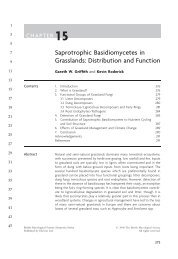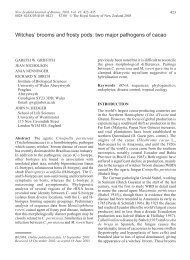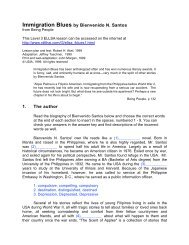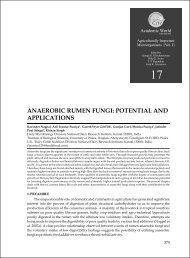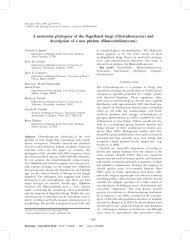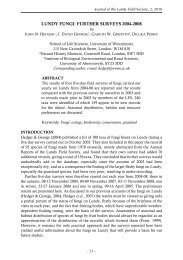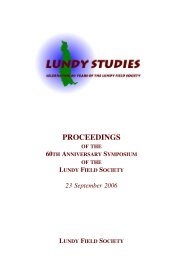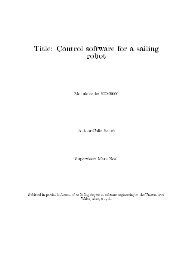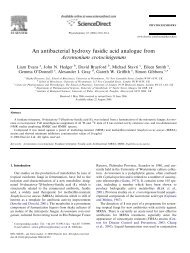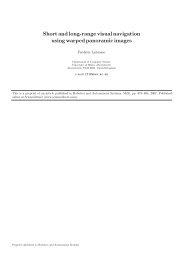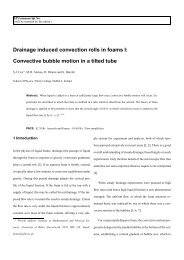Download the pdf - Users Site
Download the pdf - Users Site
Download the pdf - Users Site
You also want an ePaper? Increase the reach of your titles
YUMPU automatically turns print PDFs into web optimized ePapers that Google loves.
Plate 1: Macrolepiota procera (parasol mushroom)<br />
with <strong>the</strong> Old Light in <strong>the</strong> background.<br />
October 2003. (Photo: John Hedger)<br />
- 140 -<br />
More formal records of<br />
fungi on Lundy only began<br />
with reports of sightings,<br />
usually of <strong>the</strong> macrofungi by<br />
interested visiting members of<br />
<strong>the</strong> Lundy Field Society and<br />
<strong>the</strong>se have appeared at irregular<br />
intervals in <strong>the</strong> Annual Reports<br />
of <strong>the</strong> Lundy Field Society.<br />
The accumulated list for <strong>the</strong><br />
period 1970-1995, abstracted<br />
from <strong>the</strong> Annual Reports, was<br />
summarised in Hedger &<br />
George (2004) and stood at<br />
some ninety-five species, to<br />
which <strong>the</strong>y were able to make<br />
seventy-five additions from a<br />
week long survey in October<br />
2003. Since <strong>the</strong>n we have<br />
carried out fur<strong>the</strong>r short<br />
surveys, in November 2004,<br />
April 2005 and January 2006<br />
(Hedger, George, Griffith &<br />
Deacon unpublished data). In<br />
<strong>the</strong>se surveys <strong>the</strong> field of<br />
search was extended to <strong>the</strong> microfungi on living plants, dead wood and plant litter,<br />
and 188 additional records were made, bringing <strong>the</strong> total to 358 species. It is planned<br />
to continue to publish <strong>the</strong>se data in <strong>the</strong> Annual Reports.<br />
The object of <strong>the</strong>se studies was to start a more systematic inventory of <strong>the</strong> diversity<br />
of fungi on Lundy, and <strong>the</strong> habitats <strong>the</strong>y occupy on <strong>the</strong> island, and to begin a database<br />
of Lundy fungi for entry in <strong>the</strong> British Mycological Society U.K. recording scheme. As<br />
with most mycological surveys, we have used <strong>the</strong> identification of fruit bodies of <strong>the</strong><br />
fungi to establish <strong>the</strong> records, a practical approach, which can also be used to study <strong>the</strong><br />
ecology of different species, but with some reservations, because <strong>the</strong> active mycelium<br />
remains hidden in <strong>the</strong> soil, wood or litter. Ecological surveying in this way is<br />
equivalent to using <strong>the</strong> flowers to map plant distribution, and has its predictable defects,<br />
especially in studies of <strong>the</strong> larger fungi. In some years fungi may not fruit, in o<strong>the</strong>rs be<br />
abundant, which, combined with <strong>the</strong> shortness of study visits to <strong>the</strong> island, means that<br />
<strong>the</strong>re is a high degree of serendipity to <strong>the</strong> process. In addition, <strong>the</strong> many microfungi<br />
are much more diffÆult to survey in this way, although determination of <strong>the</strong>ir fruiting<br />
structures with hand lens and microscope on particular plants or litter indicates <strong>the</strong>ir<br />
ecological preferences. However, despite <strong>the</strong>se problems, even brief surveys can give<br />
useful information on <strong>the</strong> ecology of fungi on Lundy, especially <strong>the</strong>ir association with<br />
particular habitats and plants, and this is explored in more detail in this review.



